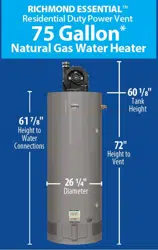Loading ...
Loading ...
Loading ...

12
The water heater must be installed with the factory installed blower assembly in place.
DANGER: Failure to
install the blower assembly
and properly vent the water
heater to the outdoors as
outlined in the Venting section
of this manual will result in
unsafe operation of the water
heater causing bodily injury,
explosion, fire or death.
To avoid the risk of fire,
explosion, or asphyxiation
from carbon monoxide,
NEVER operate the water
heater unless it is properly
vented and has adequate air
supply for proper operation
as outlined in the Venting
section of this manual.
The vent pipe must overlap
a minimum of ½ in. on each
connection. It is important
that the vent pipe engages
fully into any pipe fitting and
be kept in that position until
the adhesive has fully cured.
DO NOT drill or punch holes
in the plastic pipe or fittings.
NOTICE: This unit is
equipped with a Flammable
Vapor Sensor. DO NOT apply
power until enough time has
passed to allow the vapors
from the primer and cement
to dissipate.
Venting
This water heater is a Category III appliance.
This appliance must be vented to the
outdoors as described in these instructions.
DO NOT connect this appliance to an
existing vent or chimney - it must be vented
separately from all other appliances.
Multi-story venting is permitted in
accordance with the National Fuel Gas Code,
ANSI Z223.1/NFPA 54, and/or the Natural
gas and Propane Installation Code, CSA
B149.1, (current edition).
IMPORTANT: Multi-story and common
venting is NOT permitted for direct vent
water heaters, water heaters for installation
in manufactured homes (mobile homes),
water heaters for installation in recreational
vehicles, or water heaters for outdoor
installation.
DO NOT install thermal insulation to the
non-metallic vents pipes and fittings
NOTICE: This appliance is approved to
use the following materials for pipe of the
vent system:
PVC (DWV, ASTM-D2665 or CSA
B181.2)
PVC (Schedule 40, ASTM-D1785 or CSA
B137.3)
CPVC (CPVC 4120, ASTM-D2846 or
CSA B137.6)
CPVC (Schedule 40, ASTM-F441 or CSA
B137.3)
ABS (Schedule 40, DWV, ASTM-D2661 or
CSA B181.1)
This appliance is approved to use the
following materials for the fittings of the vent
and combustion air-intake systems:
PVC (Schedule 40 DWV, ASTM D2665)
CPVC (Schedule 40, ASTM F438)
ABS (Schedule 40 DWV, ASTM D2661)
DO NOT mix ABS pipe and fittings with
PVC or CPVC pipe fittings. Note: It is
acceptable to interchange PVC and CPVC
pipe and fittings.
Use of PVC cellular core (ASTM-F891),
ABS Schedule 40, DWV cellular
core (ASTM –F628), or Radel®
(polyphenylsulfone) in non-metallic venting
systems is prohibited.
NOTICE: This appliance may be installed
in attics provided ambient temperatures
DO NOT exceed 125°F and CPVC or ABS
pipe and fittings are used for the entire
vent system.
The vent system must be adequately
supported along both vertical and horizontal
lengths.
The vent system of this appliance may be
installed horizontally through a wall or
vertically through the roof.
Maximum unsupported length is
recommended to be no more than 4 ft.
It is very important that the first hanger be
located on the horizontal length immediately
near to the first 90-degree elbow from the
vertical rise of vent pipe connected to the
appliance.
The support method used should isolate the
vent pipes from floor joists or other structural
members to help prevent the transmission of
noise and vibration.
DO NOT support, pin or otherwise secure
the vent system in a way that restricts the
normal thermal expansion and contraction of
the chosen venting material.
If the appliance is being installed as a
replacement for an existing power vent
appliance, a thorough inspection of the
existing vent systems must be performed
prior to any installation work.
1. Verify that the correct materials as
specified in this manual have been used and
the minimum or maximum vent lengths and
terminal location as detailed in this manual
are met.
2. Carefully inspect the entire vent system
for any signs of cracks or fractures,
particularly at the joints between elbows or
other fittings and the straight length of vent
pipe.
3. Check the vent for signs of sagging or
other stresses in the joints as a result of
misalignment of any components in the
system.
4. If any of the conditions above are found,
they must be corrected in accordance
with the instructions in this manual before
completing the installation and putting the
appliance into service.
Ambient Temperature Installation
Requirements
Rheem recommends this appliance be
installed in locations where the ambient
temperatures DO NOT exceed 100°F.
DO NOT install the appliance in a location
where it may be subjected to ambient
temperatures exceeding 125°F.
The appliance should be installed so as to
minimize the length of plastic pipe and the
number of vent and combustion Air Inlet
connection fittings required.
Vent pipe materials must be chosen based
upon the ambient temperature where the
appliance is installed and the location within
the vent system.
Additional installation information for The
Commonwealth of Massachusetts is located
on the back page of this manual.
Installing the water heater
Loading ...
Loading ...
Loading ...
